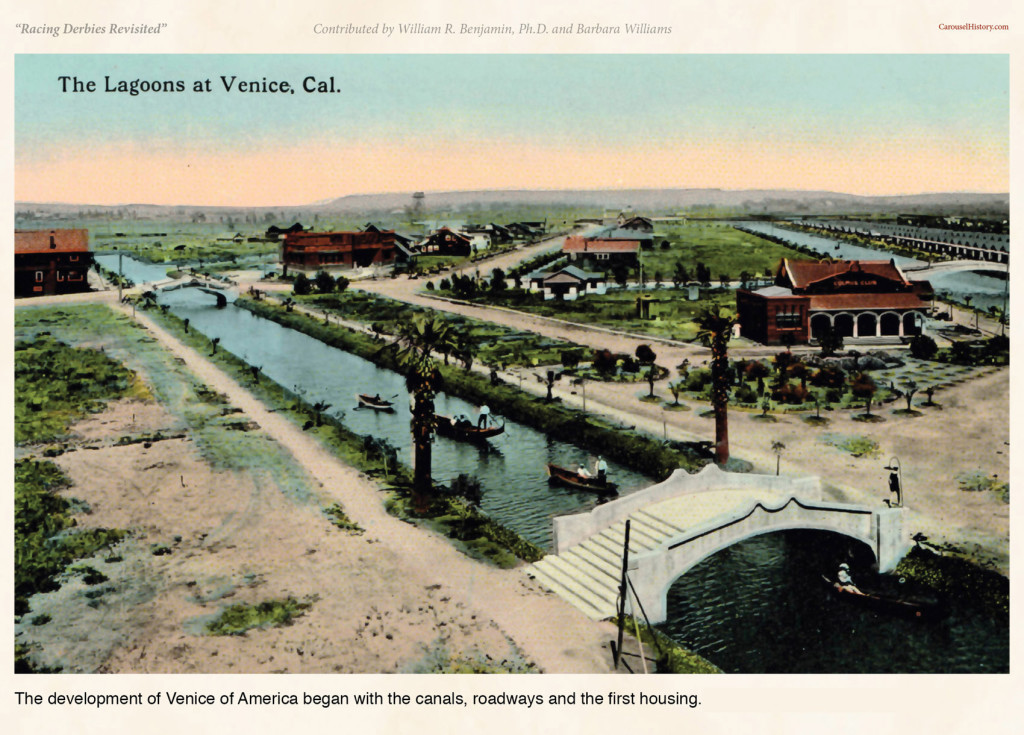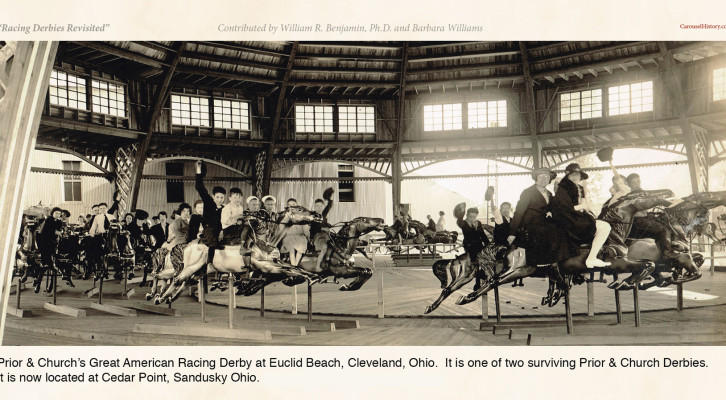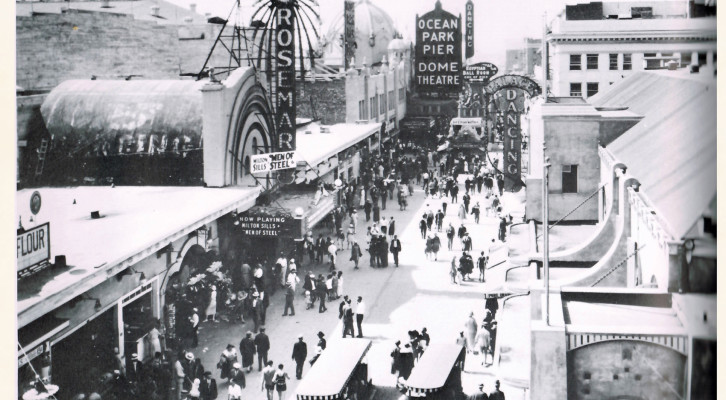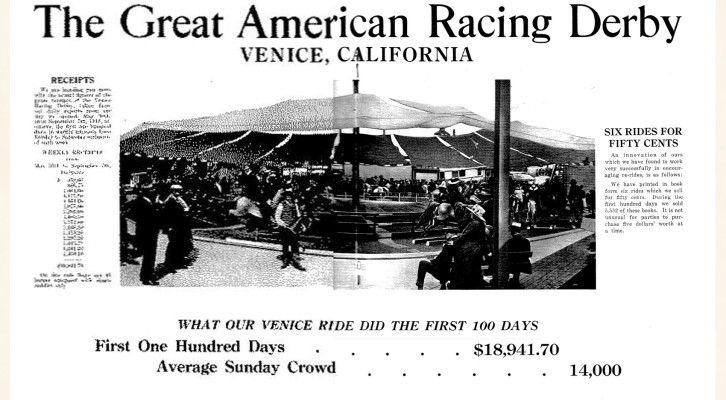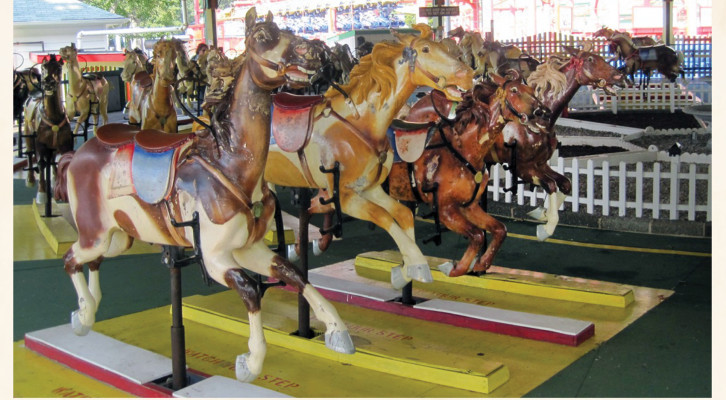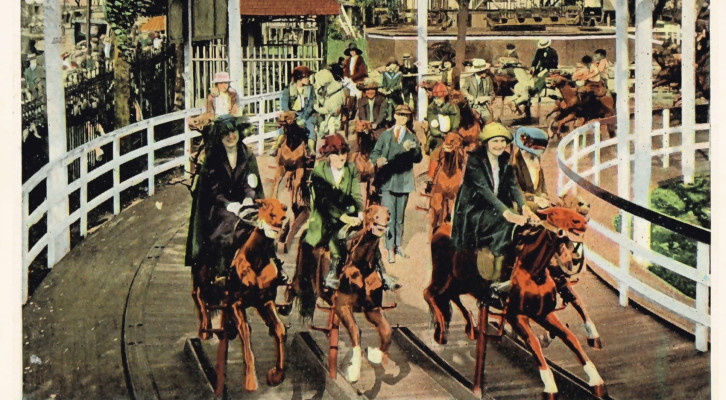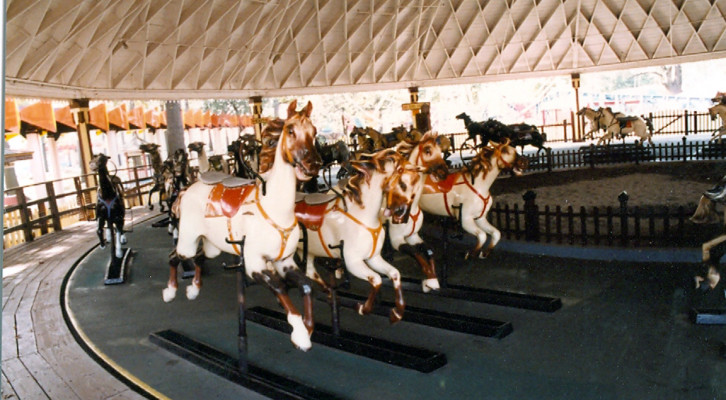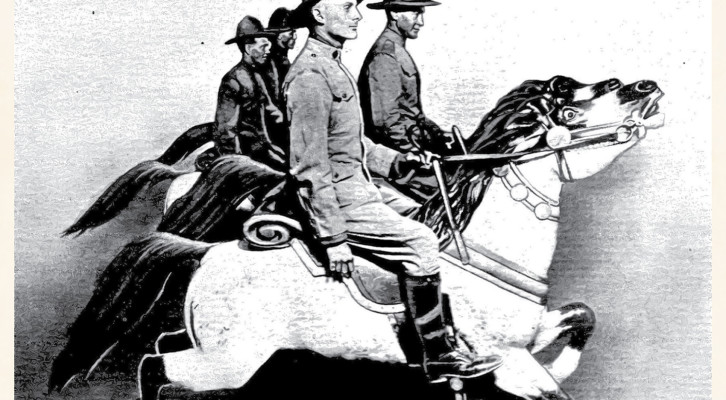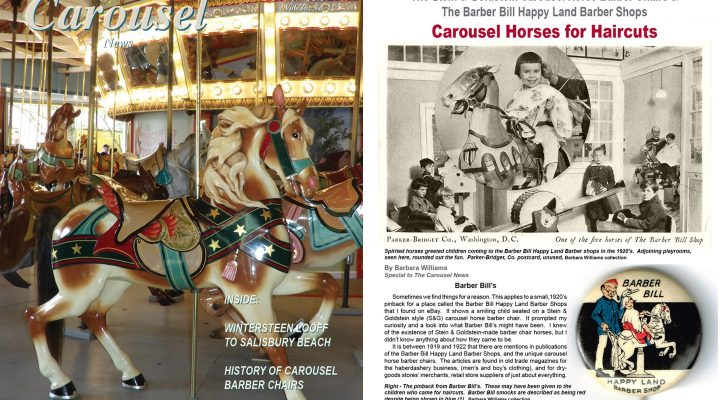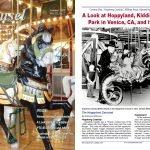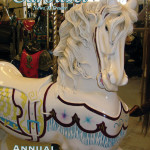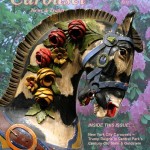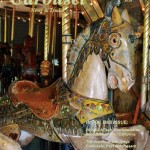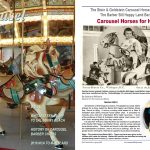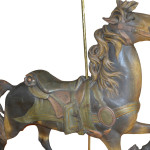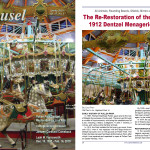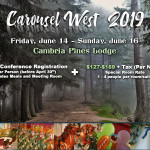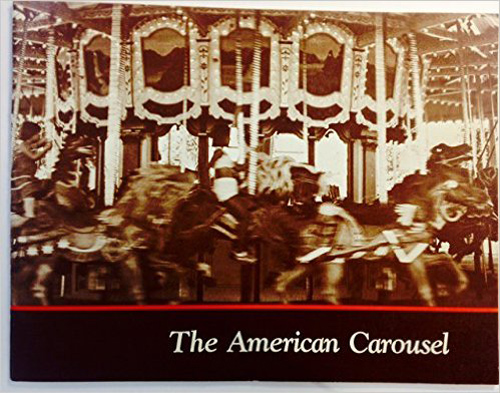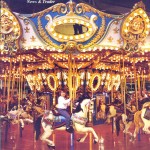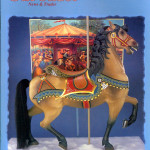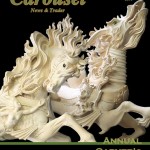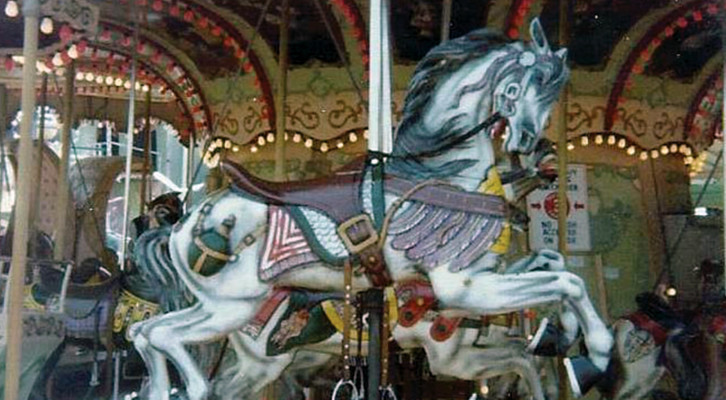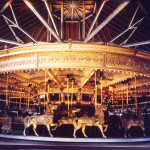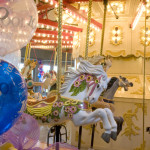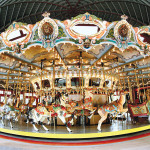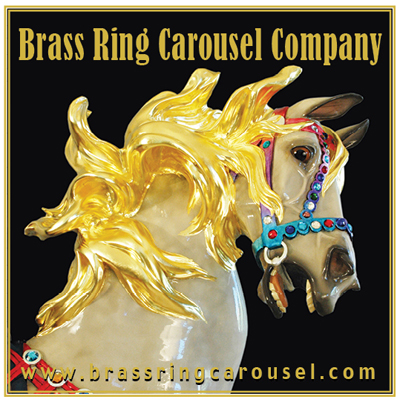Racing Derbies – Part 2 – Ocean Park, to Venice, CA:
First Prior and Church Great American Racing Derby Opens at Ocean Park, CA, Dec. 1916
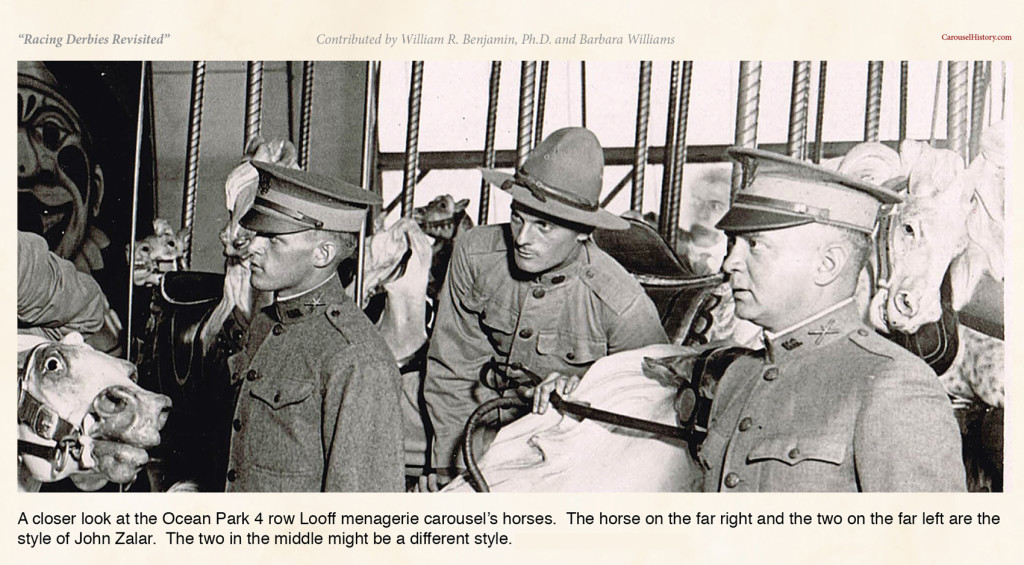
A closer look at the 4 row, menagerie Looff carousel’s horses. The horse on the far right and the two on the far left are the style of John Zalar. The two in the middle might be a different style.
Ocean Park Derby
As mentioned earlier, Tom Prior and Fred Church, both experienced in ride design, construction and operation, in particular coasters, left their respective positions in Chicago after Prior came to Venice in 1911 for a visit and saw that that there wasn’t a racing (roller) coaster. 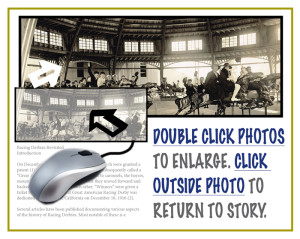 It was an opportunity just waiting for the new partnership. Venice soon had a new coaster – The Race Thru the Clouds, designed by Prior, and operated by Fred Church.
It was an opportunity just waiting for the new partnership. Venice soon had a new coaster – The Race Thru the Clouds, designed by Prior, and operated by Fred Church.
The next big venture for Prior and Church was a Great American Racing Derby ride at Ocean Park which was patented and built in 1916. The Derby had 40 horses in rows of four(3, 4). Inside of the Derby ride, was, rather amazingly, a 4 row Looff carousel (3)with all jumpers and menagerie animals(4)for the children to ride while the adults were riding the more challenging Derby(28).
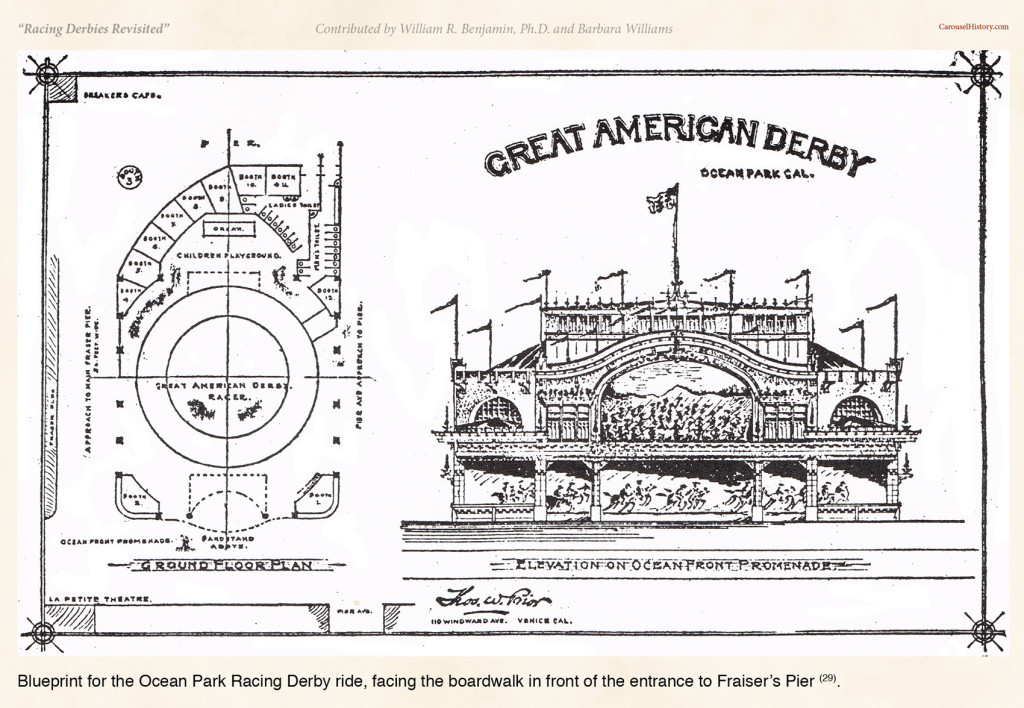
Blueprint for the Ocean Park Racing Derby ride, facing the boardwalk in front of the entrance to Fraiser’s Pier.
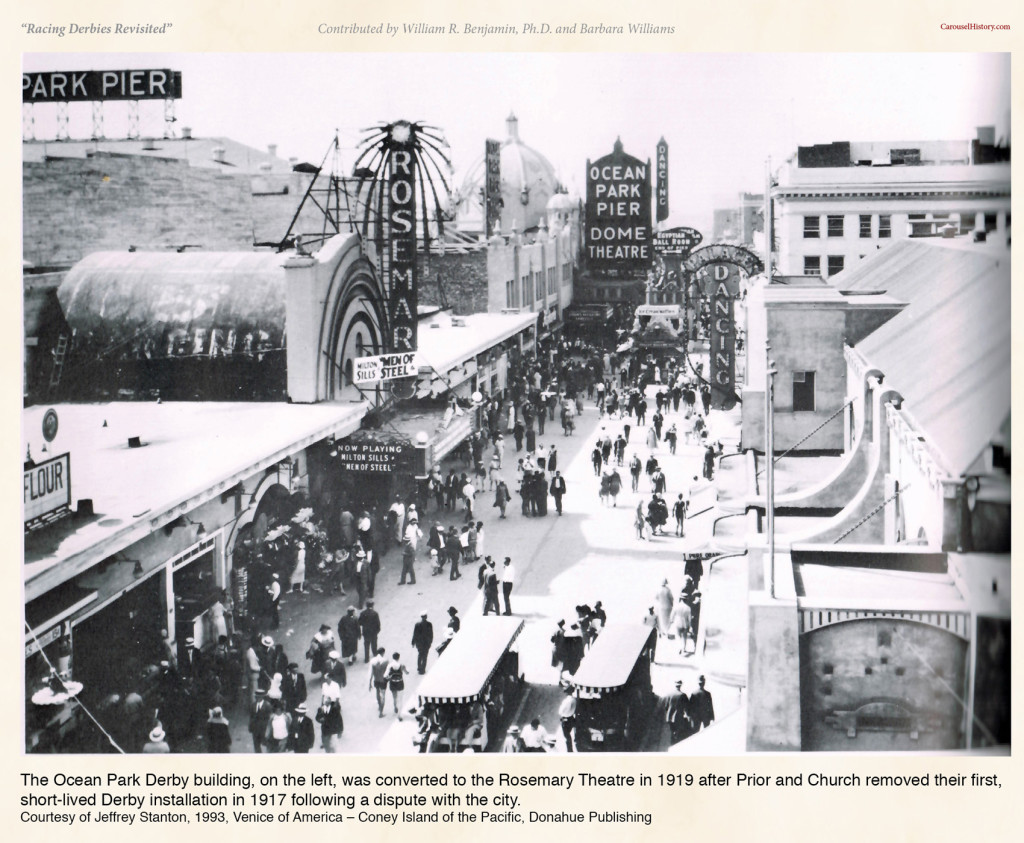
The Ocean Park Derby building, on the left, was converted to the Rosemary Theatre in 1919 after Prior and Church removed their first, short-lived Derby installation in 1917 following a dispute with the city. Courtesy of Jeffrey Stanton, 1993, Venice of America – Coney Island of the Pacific, Donahue Publishing.
The Ocean Park Derby ride opened on December 10, 1916. Crowds began to gather at noon and from then until midnight, the ride was surrounded by a huge mass of people. It was speculated that every boy and girl in the entire Bay district rode the new Derby on opening day. Cigar betting began right away with the winning horses’ riders taking the prizes(2). In earlier May publicity, the new attraction was described as “A Complete Resort In Itself”. Within the building was a carpeted, indoor children’s playground with comfortable seating for parents who could sit and enjoy the music from an 89-piece organ while their children were at play. There was space for a dozen “ornate” booths for vendors and confectioners, a band shell for concerts for use by the municipal band and public restrooms with beach access, all in addition to the carousel and the Derby (29).
Venice, California
Venice of America History
Abbott Kinney, an enterprising tobacco millionaire, founded the seaside resort of “Venice of America” in 1905. Modeled after the famed city of Venice, Italy, there was exotic, Venetian architecture and a network of meandering canals with gondola rides.
Opening on July 4, 1905, “Venice of America” started with a 1,200 foot-long pier with an auditorium, a classy restaurant in a simulated ship, dance hall, plunge and a block-long arcade on the landside. By 1913, more major attractions had been added including a scenic railway, aquarium, Virginia Reel and a Whip. Game booths, eateries, vendors and entertainment rounded out the amusements at Venice.
On the record books, the name of the original Kinney-owned parcel of land, titled “Ocean Park”, was officially changed to “Venice” in 1911. This eliminated confusion with Santa Monica’s beachfront area and amusements known as Ocean Park, located midway between “bawdy” Venice and “refined” Santa Monica, which was met with joyous approval by Santa Monica politicians and residents.
Kinney died in November of 1920 and, sadly, his pier was destroyed by fire on December 20, 1920. The Kinney family now faced with stiff competition from hastily-built, nearby amusement piers, quickly engaged in rebuilding their pier. The new Venice pier now had two roller coasters and a new Racing Derby. By 1925, with the addition of a third coaster and other attractions, the Venice Pier was known as the finest amusement pier on the West Coast.
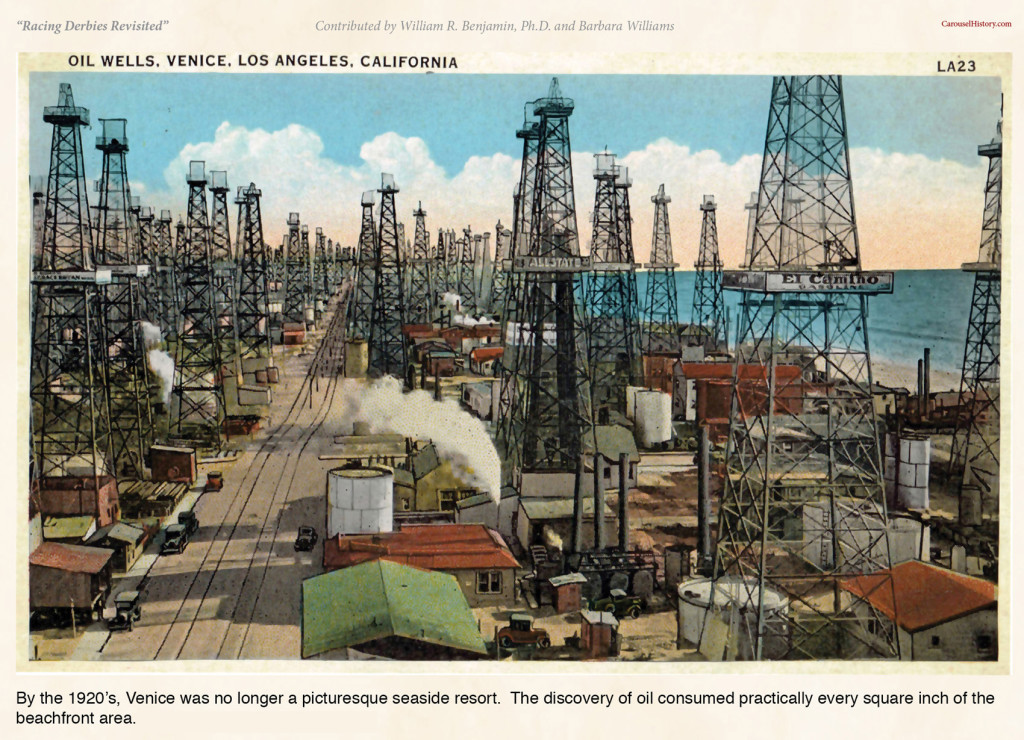
By the 1920’s, Venice was no longer a picturesque seaside resort. The discovery of oil consumed practically every square inch of the beachfront area.
But, 1925 also marked the beginning of Venice’s downfall. The canals were badly in need of repair. The ebb and flow hadn’t worked for many years, turning them into mosquito-infested, stagnant waterways. In 1925, Venice was annexed by the city of Los Angeles, with L.A. government taking over management of the area. Instead of remedying the dilemma with the canals, Los Angeles politicians turned their back to the blight. In 1929, oil was discovered at Venice and soon the beachfront was consumed by hundreds of oil wells which dumped drilling waste into the already clogged canals. Rather than fixing the canals, they began to be filled in(32). The Venice amusement pier was forced into closure in 1946. The Kinney Company’s twenty five year lease for the pier was up for renewal and the city of Los Angeles refused to renew it. This was a welcomed ending in some respects. The reputation of Venice as a honky-tonk place had been around for a long time and, by the 1940’s, it had become a down-and-out problem. Now there was hope for change. It didn’t come quickly, though. In the 1950’s, Venice was known as the “Slum by the Sea”. The controversial Beat generation set up shop in beachfront buildings. Hippies invaded Venice in the 1960’s and 70’s, bringing with them drug use counter-culture issues. More of the canals were eliminated. It wasn’t until the 1980’s that the Venice beachfront began to turn around. The canals were finally cleaned up and made functional again, the oil wells were almost all gone, and property values began to increase. Venice is now an eclectic showplace, with pricey real estate and its world-famous boardwalk. The surviving, now picturesque canals are coveted by the locals and tourists. Reminders are still in place of its colorful history in the form of original buildings and some of the original canals. The once flourishing Venice and Ocean Park piers are ghosts, with only a few remaining stray pilings as reminders of their once-upon-a-time presence(33).
Racing Derbies Revisited….
Contributed by William R. Benjamin, Ph.D. and Barbara Williams
<<< PREVIOUS – NEXT >>>
PART 1 – PART 2 – PART 3 –
PART 4 – PART 5 – PART 6 –
SUMMARY OF RIDES
<<< PREV – PART 1 – PART 2 – PART 3 – PART 4 – PART 5 – PART 6 – RIDES – NEXT >>>

